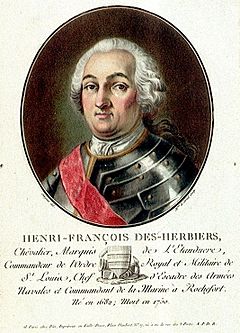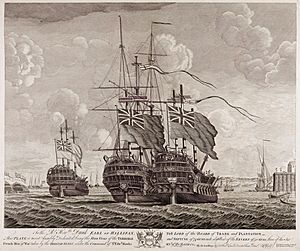Second Battle of Cape Finisterre facts for kids
Quick facts for kids Second Battle of Cape Finisterre |
|||||||
|---|---|---|---|---|---|---|---|
| Part of the War of the Austrian Succession | |||||||
 French battleship Intrépide fighting several British ships, by Pierre-Julien Gilbert |
|||||||
|
|||||||
| Belligerents | |||||||
| Commanders and leaders | |||||||
| Rear-Admiral Edward Hawke | Vice Admiral Henri-François des Herbiers | ||||||
| Strength | |||||||
| 14 ships of the line |
|
||||||
| Casualties and losses | |||||||
|
|
||||||
The Second Battle of Cape Finisterre was a big sea fight that happened on October 25, 1747. It was part of a larger conflict called the War of the Austrian Succession. In this battle, a British fleet of 14 powerful warships, led by Rear-Admiral Edward Hawke, stopped a large French convoy.
This French convoy had 250 merchant ships, which were trading vessels, sailing from western France to the West Indies. These merchant ships were protected by eight French warships, led by Vice Admiral Henri-François des Herbiers. When the two sides saw each other, Herbiers told his merchant ships to scatter and escape. He then formed his warships into a battle line to fight the British.
The British ships attacked the French warships. They managed to surround the back of the French line and attack their ships one by one. The British captured six French warships and about 4,000 French sailors. Out of the 250 merchant ships, only seven were captured. This British victory made it hard for France to send supplies and help to its colonies. The war ended the next year. Under the Treaty of Aix-la-Chapelle, France got back its captured colonies. In return, France gave up the land it had gained in the Austrian Netherlands (which is now mostly Belgium and Luxembourg).
Contents
Why the Battle Happened
The War of the Austrian Succession (1740–1748) was a big European conflict. It involved France, Spain, and Prussia fighting against Britain, Austria, and the Dutch Republic. The war started because Maria Theresa wanted to inherit her father's crown in the Habsburg Empire. But France, Prussia, and Bavaria saw it as a chance to challenge the Habsburgs and gain new lands.
France mostly focused its military efforts on its borders in Europe. Its colonies were left to manage on their own or given very few resources. This was because the British navy was very strong. It made it hard for the French navy to send many supplies or military support to French colonies. France hoped that winning battles in Europe would make up for any colonies they lost. If needed, they could trade land gained in Europe to get their colonies back. Britain, on the other hand, used its strong navy to expand its colonies. They also tried to stop enemy ships from reaching ports, a tactic called a naval blockade.
Before the Big Fight
In early 1747, a French fleet was sailing towards the Caribbean and North America. It had six ships of the line (the biggest warships) and five Indiamen (large, armed merchant ships). This fleet, led by Squadron Commander Jacques-Pierre de la Jonquière, was protecting 40 merchantmen.
On May 3, a British force of 14 ships of the line, led by Vice-Admiral George Anson, stopped them. In this first battle of Cape Finisterre, which lasted five hours, the French lost all six of their warships. They also lost two frigates, two Indiamen, and seven merchant ships. However, the French fought bravely, which helped most of their merchant ships get away. Later, on June 20, eight British ships under Commodore Thomas Fox captured 48 out of 160 French merchant ships returning from the West Indies. The French warships escorting them fled.
By summer, Admiral Anson was working in London, and his commander, Admiral Peter Warren, was sick. So, Rear-Admiral Edward Hawke, who had just been promoted, was given command of 14 ships of the line. He sailed from Plymouth on August 9. Hawke introduced new ways for ships to signal each other. This helped his fleet fight more aggressively. He also made his captains want to attack the enemy quickly, rather than just follow strict orders.
A large French convoy with strong protection was getting ready to sail from Basque Roads to the West Indies. Hawke was ordered to stop them. Even though he was new to this command, Hawke sailed far outside his given orders to make sure the convoy didn't get past him. The French convoy, led by Vice Admiral Henri-François des Herbiers, set off on October 6.
The Battle Begins
The French ships sailed on October 6. Eight days later, on the morning of October 14, the British saw them. They were about 300 miles (480 km) west of Finistère, which is the westernmost part of France. The British had 14 ships of the line. These ships were smaller, carrying between 50 and 74 guns. Only one British ship had more than 66 guns.
The French convoy had 250 merchant ships. They were protected by eight ships of the line, one Indiaman, and one frigate. The French warships were larger, carrying 56 to 80 guns, with five of them having 70 guns or more.
At first, Hawke thought he was facing a much bigger fleet of warships. So, he arranged his ships in a line of battle. Herbiers, the French commander, first thought the British ships were part of his own convoy. When he realized his mistake, he decided to use his warships to distract the British. This would allow his merchant ships to scatter and escape.
Hawke then gave the flag signal for "general chase." This meant each of his ships should go towards the enemy as fast as possible. The French had now formed their own line of battle. The Indiaman Content, the frigate Castor, and the smaller French ships stayed with the merchantmen. When the British were about 4 miles (6.4 km) from the French line, Hawke slowed down. This allowed his slower ships to catch up. Herbiers moved his line of warships away from the scattering merchant ships. This forced the British to choose: either chase the French warships, letting the merchant ships escape, or chase the merchant ships and risk being attacked from behind by Herbiers. Around 11:00 AM, Hawke again ordered "general chase" and closed in on the French warships.
The British attacked the back of the French line in a loose formation. Three British ships managed to get to the other side of the French line. This meant three French ships at the back were attacked from both sides by the British. By attacking each of these three French ships with two of their own, the British made up for their ships being individually weaker. The three French ships at the very back were also their weakest. By 1:30 PM, two of them had surrendered.
The British kept doing this as they moved up the French line. They brought several of their ships to attack each French ship. They started each attack by firing canister shot (small metal balls) into the rigging (ropes and sails) of the French ships. This made the French ships unable to move. The English sailors were better trained and more disciplined than the French. This allowed them to fire their guns faster and hit more targets. By 3:30 PM, another two French ships had surrendered.
Of the four French ships left, three were fighting ongoing battles with more British ships. Their movement was limited because their rigging was damaged. The French flagship, the Tonnant, was the most powerful ship in either fleet. It was holding off its attackers but was surrounded. The leading French ship, the Intrépide, which hadn't been fully involved yet, turned back to help. With its help, Tonnant managed to break free. The two ships escaped to the east, with the British chasing them without success. The last two French ships, attacked from all sides, surrendered. Most of the British ships had attacked as aggressively as Hawke wanted, getting very close to the enemy. One ship, the Kent, was not as committed in Hawke's opinion. Its captain was later tried by a military court and removed from the navy.
The British lost 170 men killed and 577 wounded in the battle. Hawke himself was wounded in a gunpowder explosion. The French lost about 800 killed and wounded, and 4,000 men were taken prisoner. All the British ships were damaged. All the captured French ships were badly damaged; four had all their masts shot away. Hawke's fleet had to stop for two days to make repairs.
Herbiers did succeed in his main goal: protecting the convoy. Out of 250 merchant ships, only seven were captured during the battle. The rest of the convoy continued to the West Indies. However, Hawke sent a fast ship called a sloop (the Weazel) to warn the British Leeward Islands Squadron about the approaching French ships. This British squadron was able to stop many more French merchant ships in late 1747 and early 1748. Many others were trapped in Caribbean ports.
What Happened Next
After the battle, Warren excitedly told the British government that they had "more French ships in our ports than remain in the ports of France." This battle, along with Anson's earlier victory, convinced the French government that they couldn't win at sea. They stopped trying to send convoys through the British naval blockade. This soon caused many of France's colonies, especially in the West Indies, to run low on food.
France then agreed to peace talks, even though they had won battles in other parts of Europe. The battle also gave Britain almost complete control of the English Channel during the last months of the war. It hurt the French economy and their ability to borrow money. This helped Britain get a good peace deal. In 1748, the Treaty of Aix-la-Chapelle was signed, ending the war. France got back its colonies that the British had captured. In return, France gave up the land it had gained in the Austrian Netherlands (modern Belgium and Luxembourg). The impact of these two battles at Cape Finisterre also affected the Seven Years' War (1756–1763). During that war, the French King, Louis XV, was hesitant to send men and supplies to French Canada and his other colonies.
Ships in the Battle
Here are the ships that fought in the battle:
Britain (Edward Hawke)
Ships of the line:
- Devonshire 66 (flagship, John Moore)
- Edinburgh 70 (Thomas Cotes)
- Kent 64 (Thomas Fox)
- Yarmouth 64 (Charles Saunders)
- Monmouth 64 (Henry Harrison)
- Princess Louisa 60 (Charles Watson)
- Windsor 60 (Thomas Hanway)
- Lion 60 (Arthur Scott)
- Tilbury 60 (Robert Harland)
- Nottingham 60 (Philip Saumarez †)
- Defiance 60 (John Bentley)
- Eagle 60 (George Brydges Rodney)
- Gloucester 50 (Philip Durell)
- Portland 50 (Charles Steevens)
Fourth rate:
- Hector 44 (Thomas Stanhope)
Fireships:
- Dolphin 14 (Edward Crickett)
- Vulcan (William Pettigrew)
Sloop:
- Weazel 16
France (Henri-François des Herbiers)
Ships of the line:
- Tonnant 80 (flagship, Duchaffault) – escaped
- Intrépide 74 (Comte de Vaudreuil) – escaped
- Terrible 74 (Comte du Guay) – captured
- Monarque 74 (de la Bédoyère) – captured
- Neptune 70 (de Fromentière) – captured
- Trident 64 (Marquis d'Amblimont) – captured
- Fougueux 64 (du Vignau) – captured
- Severn 56 (du Rouret de Saint-Estève) – captured
Indiaman:
- Content 64 – escaped with merchant ships
Frigate:
- Castor 26 – escaped with merchant ships
Convoy:
- 250 merchant ships




